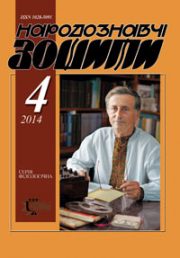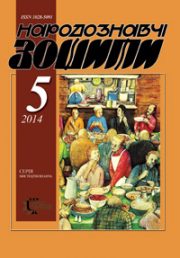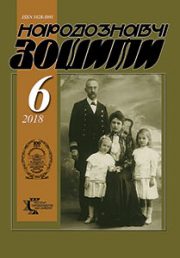The Ethnology Notebooks. 2023. № 4 (172), 933—950
UDK [39:[728.6:644.1]](477.4)”18/19″
DOI https://doi.org/10.15407/nz2023.04.933
RADOVYCH Roman
- ORCID ID: http://orcid.org/0000-0002-1900-8948
- Doctor of Sciences in History, Senior Researcher
- of the Institute of Ethnology
- of the National Academy of Sciences of Ukraine,
- in the Department of Historical Ethnology,
- 15, Svobody Avenue, 79000, Lviv, Ukraine,
- Contacts: e-mail: radovychroman@gmail.com
Abstract. Among a number of typological features that characterize traditional dwelling, the heating system occupies an important place. Considering the fact that in relation to the terrain of the Middle Transdniprian region, this issue has never been a subject of special interest to scientists, the proposed work is extremely relevant.
The author sets himself the goal of following the dynamics of the evolution of smoke removal methods and finding out the design features of the stove — the main heating device in the dwellings of the people of Transdniprian region. The object of the study is the residential heating system of the Central Transdniprian region and the subject is the evolution of smoke removal methods and the design features of the stove. The methodological basis of the research is the principle of historicism in combination with elements of structural and functional analysis and the use of the main methods of ethnological science: retrospective, typological, complex and analysis, historical reconstruction, etc. The research territory covers the entire massif of the Central Transdniprian region. Chronological boundaries — the 19th — the first half of the 20th century.
The work uses separate information about smoke removal methods and heating devices, which contain sources of the 17th—18th centuries, 19th — early 20th centuries, as well as the author’s field materials collected during expeditions in 2008—2010.
On the territory of the Central Transdniprian region n in the 19th — at the beginning of the 20th centuries. The main heating device in homes, as everywhere in Ukraine, was a stove. Older ovens were built from clay on a wooden substructure. However, the use of raw (rarely fired) bricks during the construction of stove can be attributed to at least the first half — the middle of the 19th century. The chimney heating system until the middle of the 18th century. Here it was mostly eliminated — half-smoked and white-heated dwellings became dominant. Therefore, in the middle of the 19th century heating in white has become dominant here.
Keywords: heating system, smoke heating, semi-smoke heating, white heating, stove, furnace, combustion chamber.
Received 28.06.2023
REFERENCES
- Olyanchyn, D. (1937). Description of the Travel of the Swedish Ambassador to Ukraine 1656—1657. In The Notes of the NTSh (Vol. СLІV, pp. 41—69). Lviv: NTSh [in Ukrainian].
- Beauplan, Guillaume de Levasseur, & Kravets, Ya. (1990). Description of the Ukraine, several provinces of the Kingdom of Poland, stretching from the borders of Moskov to the borders of Transylvania, together with their customs, way of life and warfare. In Guillaume Levasseur de Beauplan. Description of Ukraine. Prosper Merime. Ukrainian Cossacks. Bohdan Khmelnytskyi (Pp. 17—114). Lviv: Kamenyar [in Ukrainian].
- Markovich, J. (1798). Notes on Malorossiya, its inhabitans and products (Part 1). SPb.: under the Provincial Board [in Russian].
- Shafonsky, A. (1851). Chernigov governorship topographic description with a brief geographical and historical description of Little Russia from parts of which this governorship is composed. Kiev: In the University Printing House [in Russian].
- De la Flies, D.P., Boryak, H., & Dashkevich, Ya. (1999). Albums (Vol. 2). Kyiv: Institute of Ukrainian Archeography and Source Studies named after M. Hrushevsky National Academy of Sciences of Ukraine [in Ukrainian].
- Zelenin, D.K. (1916). Description of the manuscripts of the scientific archive of the Imperial Russian Geographical Society (Issue 3, pp. 989—1279). Petrograd: Printing house A.V. Orlov [in Russian].
- Zelenin, D.K. (1915). Description of the manuscripts of the scientific archive of the Imperial Russian Geographical Society (Issue 2, pp. 485—988). Petrograd: Printing house A.V. Orlov [in Russian].
- Fundukley, I. (1852). Statistical description of the Kiev province (Part 1). SPb.: In printing houses of the Ministry of Internal Affairs [in Russian].
- Rusov, M.A. (1902). Settlements and buildings of peasants in the Poltava province. Collectionof the Kharkov Historical and Philological Society (Vol. 13). Kharkov: Pechatnoe Dilo [in Russian].
- Myloradovych, V. (1991). The life-being of a Luben peasant. Ukrainians: popular beliefs, belief, demonology (Pp. 170—341). Kyiv: Lybid [in Russian].
- (2020). Ethnographic image of modern Ukraine. Corpus of expeditionary folklore and ethnographic materials (Vol. 9: People’s housing culture. Ecology and organization of habitat) [in Ukrainian].
- Chizhikova, L.N. (1987). Dwelling. Ethnography of Eastern Slavs. Essays on traditional culture (Pp. 223—258). Moscow: Nauka [in Russian].
- Chizhikova, L.N. (1988). Russian-Ukrainian border guards: history and destinies of traditional everyday culture. Moskow: Nauka [in Russian].
- Symonenko, I.F. (1956). Settlement, estate and housing in Transcarpathia. Materials for ethnography and artistic craft (Issue II, pp. 60—109) [in Ukrainian].
- Radovych, R. (2017). Polissya dweling: cultural and genetic origins and evolutionary processes. Lviv [in Ukrainian].
- Prykhodko, N.P. (1975). Some issues of the history of housing in Ukraine. The ancient dwelling of the peoples of Eastern Europe (Pp. 245—275) [in Russian].
- Kuchera, M.P. (1969). Ancient Plisnensk. Archaeological monuments of the Ukrainian SSR (Vol. XII, pp. 292—294). Kyiv [In Ukrainian].
- Rappoport, P.A. (1975). Old Russian dwelling. Archeology of the USSR: AIS (Issue E1—32). Leningrad: Science [in Russian].
- Niederle, L., Kovaleva, T., Khazanova, M., & Mongaita, A.L. (Ed.). (1956). Slavic antiquities. Moskow: Foreign Literature Publishing House [in Russian].
- Chkhlib, Taras. (2022). Ukraine of the 18th century. in the drawings of Johann Heinrich Munz. Kyiv: Art [in Ukrainian].
- Rusov, A.A. (1899). Description of the Chernigov province (Vol. 2). Chernigov: Printing House of the Provincial Zemstvo [in Russian].
- Kosyan, V.Kh. (Ed.). (1991). Taras Shevchenko: life and creativity in documents, photographs, illustrations. Kyiv: Soviet School [in Ukrainian].
- Radovych, R. (2021). Traditional rural housing of the third quarter of the 19th century on the territory of Podilsk province (according to source materials). The Ethnology notebooks, 3, 524—542 [in Ukrainian].
- (1873). Materials for the studi of the Podolsk province in statistical and economic relations. Kamenets-Podolsk: Printing house of the Provincial Administration [in Russian].
- Sichinskyi, V. (1992). Foreigners about Ukraine: a selection from descriptions of travels in Ukraine and other writings of foreigners about Ukraine over ten centuries. Kyiv: Dovira [in Ukrainian].
- Zuev, V. (1787). Travel notes of Vasyl Zuev from St. Petersburg to Kherson in 1781 and 1782. St. Petersburg: at the Imperial Academy of Sciences [in Russian].
- Taranushenko, S.A. (2012). House on Yelisavetinsky Ave. Under Part 35 in Kharkiv. In S.A. Taranushenko Scientific heritage. Kharkiv period. Research of 1918—1932 (Pp. 21—48). Kharkiv: Publisher Savchuk O.O. [in Ukrainian].
- Sharko, A. (1901). Little Russian housing. Ethnographic review, 4, 119—131 [in Russian].
- Padalka, L.V. (1905). What did the population of the Poltava provincesey about their old life. Proceedings of the Poltava Scientific Archive Commission (Issue 2, pp. 22—29). Poltava [in Russian].
- Kovalenko, G. (1912). About Ucrainian style and Ucrainian house. Ucrainian house (Pp. 166—201, 272—282). Kyiv [in Ukrainian].
- Кosmina, T.V. (1980). Rural habitation of Podillya (end of 19—20 centuries): Historical and ethnographic research. Kiev: Scientific Opinion [in Ukrainian].
- Blomkvist, E.E. (1956). Peasant buildings of Russians, Ukrainians and Belorussians: (settlements, dwellings and economic structures). In East Slavic ethnographic collection: Essays on folk material culture of Russians, Ukrainians and Belarusians in the 19 — early 20 centuries (Pp. 3—458). Moscow: Publishing House of the Academy of Sciences of the USSR [in Russian].
- Vozny, I.P. (2009). Historical and cultural development of the population of the confluence of the Upper Siret region and the Middle Dniester region in the 10th—14th centuries (Part 2: Material, spiritual culture and socio-historical development). Chernivtsi: Zoloti Litavry [in Ukrainian].
- Tymoshchuk, B.O. (1978). Fortress on Prut: from the history of Chernivtsi. Uzhhorod: Carpathians [in Ukrainian].
- Vovk, Hv. (1995). Ethnographic features of the Ukrainian people. Studies on Ukrainian ethnography and anthropology (Pp. 39—218). Kiev: Art [in Ukrainian].
- Pugolovok, Yu. (2016). The construction business of the annals of northerners. Description: Ukrainian folklore [in Ukrainian].
- Lysenko, P.F. (1985). Berestie. Minsk: Science and Technology [in Russian].
- Sergeeva, M. (1999). Formation of the interior of medieval housing. In Ukrainian: historical and ethnographic monography in two books (Vol. 2, pp. 65—74). Opishne: Ukrainian Genre Studies [in Ukrainian].
- Moszynki, K. (1929). Folk culture of the Slavs. Material culture (Vol. 1)[in Polish].
- Hrushevskyi, M. (2002). From the life of peasants in the Chihyryn region. Sights of Ukraine: history and culture, 2, 127—135 [in Ukrainian].
- Hlushko, M. (2017). Little-known study of Marko Hrushevskyi. The Ethnology notebooks, 3, 531—540 [in Ukrainian].
- Syvak, V. (2017). General characteristics of the interior of the national dwelling of the Carpathian Ukrainians of the end of the 19th — the first half of the 20th century (common features, local specificity, dynamics of development). The Ethnology notebooks, 6, 1281—1306 [in Ukrainian].
- Symonenko, I.F. (1949). Materials for the history of the oven in the territory of Ukraine. Brief reports of the Institute of Ethnography of the Academy of Sciences of the USSR (Vol. 8, pp. 10—18) [in Russian].
- Siletskyi, R. (2001). The problem of typology of heating devices of ancient dwellings in Ukraine (constructive and functional features of the furnace). Notes of NTSH (Pp. 230—247) [in Ukrainian].
- (1858). Life of the Malorussian peasant (Mostly in the Poltava province). Ehtnographic collection published by the Imperial Russian Geographic Society (Issue III, pp. 19—46). SPb.: In the printing house of Eduard Prats [in Russian].
- Chubinsky, P.P. (1877). Russians of the South-Western Territory: housing, utensils, farm buildings and tools. In Proceedings of the ethnographic and statistical expedition to the West Russian Region, equipped with the Russian Geographical Society of the South-West Division (Vol. 7, issue 2, pp. 339—606). SPb. [in Russian].
- Shcherbakivskyi, V., & Ulyanovsky, A. (Ed.). (1995). Ukrainian Art: Selected Unpublished Works. Kyiv: Lybid [in Ukrainian].
- Shevchenko, L. (1926). Customs related to building deposits. Original citizenship. His remains in Ukraine (Issue 1—2, pp. 87—95). Kyiv [in Ukrainian].
- Haiova, E. (2019). Peculiarities of the revival of the material culture of Velykyi Bereznyi district in the exhibition «Carpathians» of the National Museum of Folk Architecture and Life of Ukraine. Scientific collection of the Transcarpathian Museum of Folk Architecture and Life (Issue 6, pp. 147—165) [in Ukrainian].
- Siletskyi, R. (1994). The heating system of a traditional house. In Archive of the Institute of Ethnology of the National Academy of Sciences of Ukraine. F. 1. Ds. 2. Un. save 410. Arcs. 1—49 [in Ukrainian].
- Ivanitsa, A. (1853). Household life of Maloros, Poltava province, Khorolsk district. Ehtnographic collection published by the Imperial Russian Geographic Society (Issue 1, pp. 337—371). SPb.: In the printing house of Eduard Prats [in Russian].







